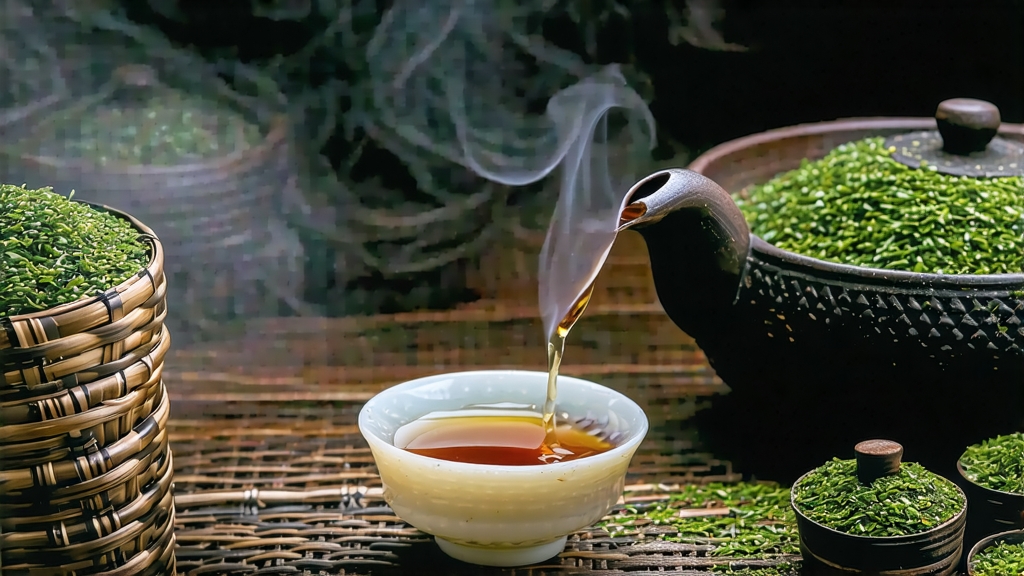
Tucked away in the humid, karst-pocked mountains of southern Guangxi, Liu Bao tea has spent four centuries quietly transforming itself from a coolie’s thirst-quencher into one of China’s most cellar-worthy treasures. To the uninitiated it is merely another dark brick, but to the initiated it is liquid time—an ever-evolving dialogue between leaf, microbe, and the subtropical air that drifts up the Liu River. This essay invites the global tea traveler to listen in on that conversation: to understand where Liu Bao came from, how it is coaxed into being, and why a well-aged 1980s basket can smell like plum wine, camphor, and a just-struck match all at once.
-
Historical Footprints along the Tea-Horse Road
Liu Bao takes its name from the old trading town of Liubao in Wuzhou prefecture, once the last major riverine stop before tea entered the Pearl Delta and, ultimately, the South China Sea. During the Qing dynasty, imperial edicts designated the tea as “medicinal for the southern barbarians,” and it was compressed into 40-kilogram bamboo baskets, loaded onto bamboo rafts, and floated down the Liu River to Guangzhou. From there clipper ships carried it to British Hong Kong, Malaya, and the tin mines of Ipoh, where Indian and Chinese laborers prized it for dissolving the pork fat that lubricated their rice-heavy diets. In 1847 the German missionary Karl Gützlaff noted that “the coolies drink a black infusion so dark it resembles coffee, yet it sweetens the breath and lightens the limbs.” That black infusion was Liu Bao, already double-fermented and deliberately aged. -
Terroir: Karst, Mist, and the Subtropical Microbiome
The tea gardens lie between 200 and 800 m above sea level on red lateritic soil rich in iron and aluminum oxides. Morning fog rising off the Liu River keeps leaf moisture high, while the afternoon karst wind pulls it away again; this diurnal seesaw concentrates amino acids and invites a native consortium of Aspergillus niger, Blastobotrys adeninivorans, and a unique strain of Eurotium cristatum known locally as “golden flower” (though it appears more amber than the golden flecks on Fu bricks). The result is a leaf that arrives at the factory already half-colonized, a microbial head-start that would be impossible to replicate in a dryer Yunnan or a cooler Anhui. -
Harvest Calendar and Leaf Grade
Liu Bao is plucked in four seasonal flushes:- Spring (qingming to guyu): one bud and two leaves, high in theanine, destined for boutique baskets.
- Summer (lixia to xiaoman): larger blades, higher polyphenol oxidase activity, favored for long-distance export.
- Autumn (baolu to hanlu): balanced chemistry, traditionally reserved for “three-year” commercial grades.
- Winter (lidong to daxue): hardy mature leaves, high in fiber, ideal for the 40 kg export baskets once known as “coolie tea.”
Each grade is coded by a three-digit number: 8128 for spring tips, 8218 for summer medium leaf, 8318 for autumn mature leaf, and 8408 for winter “big leaf.” The first digit indicates the season, the second the leaf maturity, and the last two the intended aging cycle in years.
- Crafting Liu Bao: From Kill-Green to Riverine Cellar
Step 1: Sha Qing (Kill-Green)
Leaves are pan-fired at 280 °C for three minutes, enough to denature polyphenol oxidase but not to drive off all moisture; residual water is crucial for the subsequent wet piling.
Step 2: Lian Du (Rolling)
A 55-minute low-pressure roll ruptures 35 % of cell walls without macerating the leaf, preserving the integrity needed for basket compression.
Step 3: Dui Wo (Wet Piling)
Unique among dark teas, Liu Bao is piled directly on bamboo mats 60 cm high and sprayed with Liu River water whose pH hovers at 6